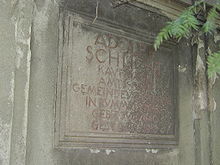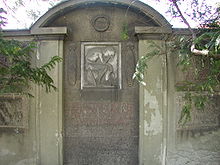Adolph Schlicht
Adolph Schlicht (born July 3, 1840 in Rummelsburg ; † August 9, 1910 there ) was a local politician (head of the office and community of Boxhagen-Rummelsburg near Berlin).
Life
Adolph Schlicht had learned the trade of a businessman and practiced it in his place of birth. He was married to Albertine Schlicht (* March 3, 1842, † August 15, 1914).
Community leader 1889 to 1901
In 1889 a suitable person was sought for the voluntary work of a community leader, and Adolph Schlicht took over this position. The reason for this new office was that the Boxhagen-Rummelsburg manor district was dismissed from the association of the German capital at that time, because the city treasury incurred enormous financial burdens caused by the rapid growth of the workers' suburbs: for around 10,000 residents there were apartments, To create transport links and the like. The now independent community led Schlicht initially from his apartment; In 1891 he set up a small office in the community school. The municipal administration faced the following tasks:
- commission a town hall,
- build a larger school building,
- the laying of drinking water pipes, the connection of the gas supply and the just emerging electricity for the houses had to be arranged,
- organize the provision of a school breakfast for poor children,
- Official baby care as well as a system of school doctors who carried out regular examinations of school children had to be introduced.
All of this happened because of the enormous pressure of external conditions and developments in other areas around Berlin , not for charitable reasons. The architect and master carpenter Rudolf Goltsch carried out the construction of the Rummelsburg town hall, which was inaugurated by Adolph Schlicht on today's Stadthausstraße / Türrschmidtstraße in the Victoriastadt on March 22, 1901. According to a contemporary description, it had a high front gable richly decorated with ornaments . In addition to offices for the various administrative units, there was space for apartments, shops and an office building . However, the community's debts increased due to this huge package of measures, so that Schlicht did not stand for re-election after the inauguration of the town hall.
Rummelsburg without plain
The school building (today the Immanuel-Kant-Gymnasium ) was built by the municipal master builder Ringel in 1906/1907 on today's Lückstrasse. The official business was then carried on by Lord Mayor Hahn, who was experienced in the city of Zerbst , but the Rummelsburgers could no longer get out of the debt trap on their own. A connection to Berlin was requested. However, when the then prosperous city refused, negotiations were made to join the city of Lichtenberg . In 1912 the time had come when Boxhagen-Rummelsburg was incorporated there under Oskar Ziethen . With this, the former town hall lost its function, but continued to serve as a town hall for the Lichtenberg district administration. It has about 125 rooms. It was partially destroyed in the Second World War, and the Lichtenberg Museum is now in the remaining part of the building.
Honor
The former Kietzer Weg has been called Schlichtallee since 1901 , which means that Schlicht's work for Rummelsburg was recognized during his lifetime. In the meanwhile abandoned cemetery on Rummelsburger Strasse , the family was buried in a simply designed grave complex that can still be seen today - albeit behind wild bushes - and behind a war cemetery. Schlicht's grave is a listed building.
literature
- Jan Feustel : Walks in Lichtenberg , Verlag Haude and Spener 1996, ISBN 3775904093
Individual evidence
| personal data | |
|---|---|
| SURNAME | Simple, Adolph |
| BRIEF DESCRIPTION | Berlin local politician |
| DATE OF BIRTH | July 3, 1840 |
| PLACE OF BIRTH | Rummelsburg |
| DATE OF DEATH | August 9, 1910 |
| Place of death | Rummelsburg |

